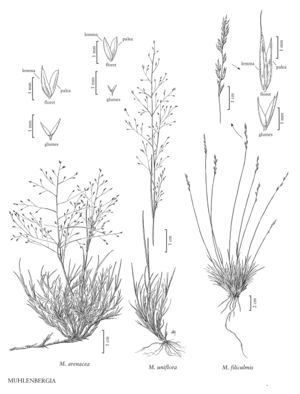Difference between revisions of "Muhlenbergia uniflora"
FNA>Volume Importer |
FNA>Volume Importer |
||
| Line 17: | Line 17: | ||
-->{{Treatment/Body | -->{{Treatment/Body | ||
|distribution=Maine;Md.;N.J.;Conn.;N.Y.;Mass.;N.H.;Minn.;Mich.;Wis.;R.I.;Pa.;Vt.;B.C.;N.B.;Nfld. And Labr.;N.S.;Ont.;Que.;Oreg. | |distribution=Maine;Md.;N.J.;Conn.;N.Y.;Mass.;N.H.;Minn.;Mich.;Wis.;R.I.;Pa.;Vt.;B.C.;N.B.;Nfld. And Labr.;N.S.;Ont.;Que.;Oreg. | ||
| − | |discussion=<p>Muhlenbergia uniflora grows in bogs, wet meadows, and lake shores in sandy or peaty, often acidic, soils, at elevations of 0-650 m. It is native to eastern North America, but was collected once in British Columbia, probably having been introduced from ship ballast, and was recently collected from a commercial cranberry bog in Oregon. The collection from Texas may also be an introduction.</p> | + | |discussion=<p><i>Muhlenbergia uniflora</i> grows in bogs, wet meadows, and lake shores in sandy or peaty, often acidic, soils, at elevations of 0-650 m. It is native to eastern North America, but was collected once in British Columbia, probably having been introduced from ship ballast, and was recently collected from a commercial cranberry bog in Oregon. The collection from Texas may also be an introduction.</p> |
|tables= | |tables= | ||
|references= | |references= | ||
| Line 26: | Line 26: | ||
-->{{#Taxon: | -->{{#Taxon: | ||
name=Muhlenbergia uniflora | name=Muhlenbergia uniflora | ||
| − | |||
|authority=(Muhl.) Fernald | |authority=(Muhl.) Fernald | ||
|rank=species | |rank=species | ||
| Line 33: | Line 32: | ||
|basionyms= | |basionyms= | ||
|family=Poaceae | |family=Poaceae | ||
| − | |illustrator=Linda A. Vorobik | + | |illustrator=Linda A. Vorobik;Annaliese Miller |
| + | |illustration copyright=Utah State University | ||
|distribution=Maine;Md.;N.J.;Conn.;N.Y.;Mass.;N.H.;Minn.;Mich.;Wis.;R.I.;Pa.;Vt.;B.C.;N.B.;Nfld. And Labr.;N.S.;Ont.;Que.;Oreg. | |distribution=Maine;Md.;N.J.;Conn.;N.Y.;Mass.;N.H.;Minn.;Mich.;Wis.;R.I.;Pa.;Vt.;B.C.;N.B.;Nfld. And Labr.;N.S.;Ont.;Que.;Oreg. | ||
|reference=None | |reference=None | ||
| Line 39: | Line 39: | ||
|publication year= | |publication year= | ||
|special status= | |special status= | ||
| − | |source xml=https:// | + | |source xml=https://jpend@bitbucket.org/aafc-mbb/fna-data-curation.git/src/f50eec43f223ca0e34566be0b046453a0960e173/coarse_grained_fna_xml/V25/V25_756.xml |
|subfamily=Poaceae subfam. Chloridoideae | |subfamily=Poaceae subfam. Chloridoideae | ||
|tribe=Poaceae tribe Cynodonteae | |tribe=Poaceae tribe Cynodonteae | ||
Revision as of 20:37, 16 December 2019
Plants perennial; loosely matted. Culms 5-45 cm, arising from the bases of old depressed culms, compressed-keeled, developing branches below the lower leaf nodes; internodes mostly glabrous, sometimes minutely puberulent below the nodes. Sheaths longer than the internodes, keeled, keels scabridulous, not becoming papery or spirally coiled when old; ligules 0.5-1.5 mm, membranous, truncate to obtuse, erose, without lateral lobes; blades 1-15 cm long, 0.8-2 mm wide, flat to conduplicate, smooth or scabridulous abaxially, hirtellous adaxially, midveins thickened and whitish proximally. Panicles 2-20 cm long, (0.2)2.5-6 cm wide, diffuse; primary branches 0.4-6 cm long, about 0.1 mm thick, ascending, diverging 10-60° from the rachises, naked basally; pedicels 0.2-7 mm, glabrous. Spikelets 1.3-2.1 mm, dark purplish to plumbeous, occasionally with 2 florets. Glumes equal, 0.4-1.3 mm, glabrous, 1-veined, apices scabrous, acute to obtuse, sometimes erose or notched, unawned; lemmas 1.2-2 mm, oblong-elliptic, dark purplish to plumbeous, glabrous, faintly 3-veined, apices acute to obtuse, unawned; paleas 1.3-2.1 mm, oblong-elliptic, glabrous, acute to obtuse; anthers 0.6-0.9 mm, dark purple. Caryopses 0.6-0.8 mm, ovoid, brownish. 2n = 42.
Distribution
Maine, Md., N.J., Conn., N.Y., Mass., N.H., Minn., Mich., Wis., R.I., Pa., Vt., B.C., N.B., Nfld. And Labr., N.S., Ont., Que., Oreg.
Discussion
Muhlenbergia uniflora grows in bogs, wet meadows, and lake shores in sandy or peaty, often acidic, soils, at elevations of 0-650 m. It is native to eastern North America, but was collected once in British Columbia, probably having been introduced from ship ballast, and was recently collected from a commercial cranberry bog in Oregon. The collection from Texas may also be an introduction.
Selected References
None.
